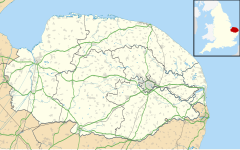world.wikisort.org - United_Kingdom
Brundall is a village and civil parish in the English county of Norfolk. It is located on the north bank of the River Yare opposite Surlingham Broad and about 7 miles (11 km) east of the city of Norwich.
| Brundall | |
|---|---|
 Church of St Laurence, Brundall | |
 Brundall Location within Norfolk | |
| Area | 4.39 km2 (1.69 sq mi) |
| Population | 4,019 (2011)[1] |
| • Density | 915/km2 (2,370/sq mi) |
| OS grid reference | TG325085 |
| Civil parish |
|
| District | |
| Shire county | |
| Region | |
| Country | England |
| Sovereign state | United Kingdom |
| Post town | NORWICH |
| Postcode district | NR13 |
| Police | Norfolk |
| Fire | Norfolk |
| Ambulance | East of England |
| UK Parliament |
|
History
Brundall's name is of Anglo-Saxon origin and likely derives from the Old English for a small area of dry land with an abudance of broom.[2]
In the Domesday Book, Brundall is recorded as consisting of 70 households belonging to King William, Bishop William of Thetford and Gilbert the Bowman.[3]
In 1874, Brundall was the location of the Thorpe rail accident, a major head-on collision between two railway locomotives which resulted in the deaths of 25 people.
In 1898, the boatbuilder, Brooms of Brundall, was established. This company has built high quality watercraft and operated water tours on the Broads for over one hundred years and is still in operation.[4]
Geography
The civil parish has an area of 4.39 km2 and in the 2001 census had a population of 3,978 people in 1,681 households, increasing to a population of 4,019 in 1,765 households at the 2011 Census.
For the purposes of local government, the parish falls within the district of Broadland. As in other broadland villages, the land lying directly adjacent to the river falls into the executive area of the Broads Authority.
Transport
The village is served by Brundall and Brundall Gardens railway stations, which are both on the Norwich to Great Yarmouth and Lowestoft Wherry Lines.
St. Lawrence's Church
Brundall's Parish Church is a tower-less church dating from the Thirteenth Century and is dedicated to Saint Lawrence. Furthermore, St. Lawrence's is home to East Anglia's only lead church font and the stained-glass windows were created by Clayton and Bell and Charles Eamer Kempe.[5]
Notable Residents
- Robert Ashton- British historian
- Robert Blake- English historian and biographer
- Sam Clemmett- British actor
- Bruce Rushin- English art teacher and coin designer
War Memorial
Brundall's War Memorial takes the form of a stained glass window for the First World War and a marble plaque for the Second World War. The First World War memorial lists the following names:
- Second-Lieutenant Walter H. Benn (d.1917), 7th Battalion, Royal Norfolk Regiment
- Sub-Lieutenant Claude C. Sennitt (1892-1917), Hood Battalion, Royal Naval Division
- Corporal James H. Harper (1888-1918), 333rd (Siege) Battery, Royal Garrison Artillery
- Private Richard R. Minns (d.1918), 8th Battalion, Border Regiment
- Private James Holsworth (1897-1916), 1st Battalion, Royal Norfolk Regiment
- Private Herbert Smith (d.1918), 7th Battalion, Royal Norfolk Regiment
- Private Frank Smith (1896-1916), 8th Battalion, Royal Norfolk Regiment
And, the following for the Second World War:
- Pilot-Officer John H. Braybrooks (1912-1942), Royal Air Force
- Pilot-Officer Sidney C. Braybrooks (1885-1941), No. 224 Squadron RAF
- Lieutenant Austin S. Carruthers (1920-1945), Royal Army Medical Corps
- Leading-Aircraftman E. R. John Spooner (1922-1942), Royal Air Force
- Sergeant John R. Mace (1914-1943), No. 158 Squadron RAF
- Sergeant Wilfrid Jaques (1916-1943), 196th Field Ambulance, Royal Army Medical Corps
- Able-Seaman George W. Moorby (1906-1942), S.S. Glenlea
- Private Percy J. Horner (1920-1943), 4th Battalion, Royal Norfolk Regiment
- Private Stanley C. Cork (1920-1943), 5th Battalion, Royal Norfolk Regiment[6]
References
- "Civil Parish population 2011". Neighbourhood Statistics. Office for National Statistics. Archived from the original on 11 October 2016. Retrieved 31 July 2016.
- University of Nottingham. (2022). Retrieved November 13, 2022. http://kepn.nottingham.ac.uk/map/place/Norfolk/Brundall
- Domesday Book. (1086). Retrieved November 13, 2022. https://opendomesday.org/place/TG3208/brundall/
- Broom Boats Brundall. (2022). Retrieved November 13, 2022. https://www.broomboats.com/about/heritage/
- Knott, S. (2020). Retrieved November 13, 2022. http://www.norfolkchurches.co.uk/brundall/brundall.htm
- Edwards, M. (2006). Retrieved November 13, 2022. http://www.roll-of-honour.com/Norfolk/Brundall.html
- ^ Ordnance Survey (2005). OS Explorer Map OL40 - The Broads. ISBN 0-319-23769-9.
- ^ Office for National Statistics & Norfolk County Council (2001).
External links
- Map sources for Brundall.
На других языках
[de] Brundall
Brundall ist ein Dorf und Civil parish in der Grafschaft Norfolk. Es befindet sich am Fluss Yare etwa 11 km östlich von Norwich.- [en] Brundall
Другой контент может иметь иную лицензию. Перед использованием материалов сайта WikiSort.org внимательно изучите правила лицензирования конкретных элементов наполнения сайта.
WikiSort.org - проект по пересортировке и дополнению контента Википедии